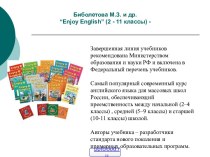- Главная
- Разное
- Бизнес и предпринимательство
- Образование
- Развлечения
- Государство
- Спорт
- Графика
- Культурология
- Еда и кулинария
- Лингвистика
- Религиоведение
- Черчение
- Физкультура
- ИЗО
- Психология
- Социология
- Английский язык
- Астрономия
- Алгебра
- Биология
- География
- Геометрия
- Детские презентации
- Информатика
- История
- Литература
- Маркетинг
- Математика
- Медицина
- Менеджмент
- Музыка
- МХК
- Немецкий язык
- ОБЖ
- Обществознание
- Окружающий мир
- Педагогика
- Русский язык
- Технология
- Физика
- Философия
- Химия
- Шаблоны, картинки для презентаций
- Экология
- Экономика
- Юриспруденция
Что такое findslide.org?
FindSlide.org - это сайт презентаций, докладов, шаблонов в формате PowerPoint.
Обратная связь
Email: Нажмите что бы посмотреть
Презентация на тему Scotland
Содержание
- 2. Scotland, one of the four national units that make up the United
- 3. Scotland and its offshore islands comprise the northernmost part of
- 4. Scottish HighlandsScottish HighlandsSummit of Ben NevisScotland's Grampian Region
- 5. Rivers and Lakes Scotland is endowed with an abundance of
- 6. Castle on Loch NessLoch LomondRiver Tweed
- 7. Climate Like the rest of the United Kingdom, the climate of Scotland
- 8. BadgerMartenOtterEagle
- 9. OakWillowFirPine
- 10. POPULATION The people of Scotland, like those of the United
- 12. Principal Cities Glasgow (population, 2001, 578,700) is Scotland’s largest
- 13. George Square, GlasgowPalace of Holyroodhouse, EdinburghEdinburgh Castle and Balmoral Hotel
- 14. Culture Historic cultural differences long divided Celtic Scots of
- 16. Highland Dancers of ScotlandTraditional Highland dances of
- 18. Scotland has a rich musical heritage. The traditional instruments of Scotland
- 19. Sports have an important place in Scottish life. The most
- 21. FOODHaggis – Scottish national dish, chopped lamb
- 22. Scotch WhiskyWhisky - Scotland's national drink, in
- 23. Saint AndrewThe Royal Flag of ScotlandNational emblem
- 24. Political subdivisionFor the purposes of local government,
- 26. Scotland is governed as an integral part of the United
- 27. The official head of Scotland is the British Monarch
- 28. SubdivisionsHistorical, geographical and political areasCity status in
- 29. EdinburghSituated on the east coast of Scotland's
- 31. GlasgowScotland's largest cityon the River Clyde in
- 33. Customs of Scotland Marriage and FamilyEarly families
- 34. EatingThe traditional breakfast includes porridge (oats mixed
- 35. SocializingA handshake is usual when people are
- 36. Скачать презентацию
- 37. Похожие презентации
Scotland, one of the four national units that make up the United Kingdom of Great Britain and Northern Ireland. Edinburgh is the capital of Scotland, and Glasgow is its largest city.




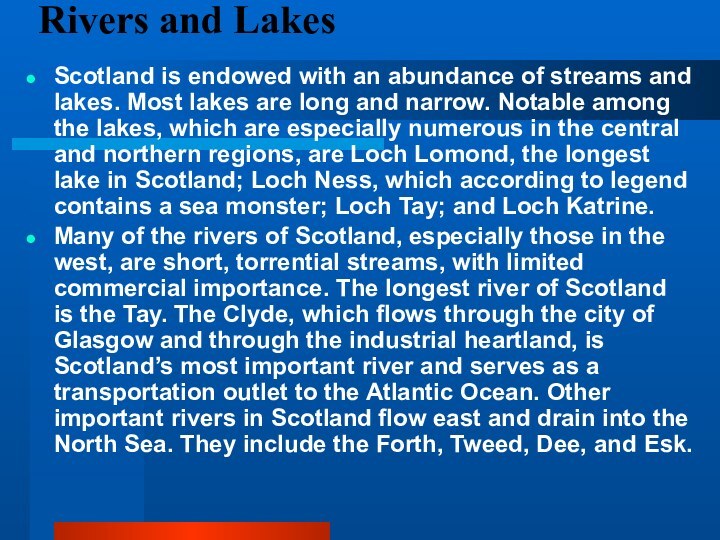














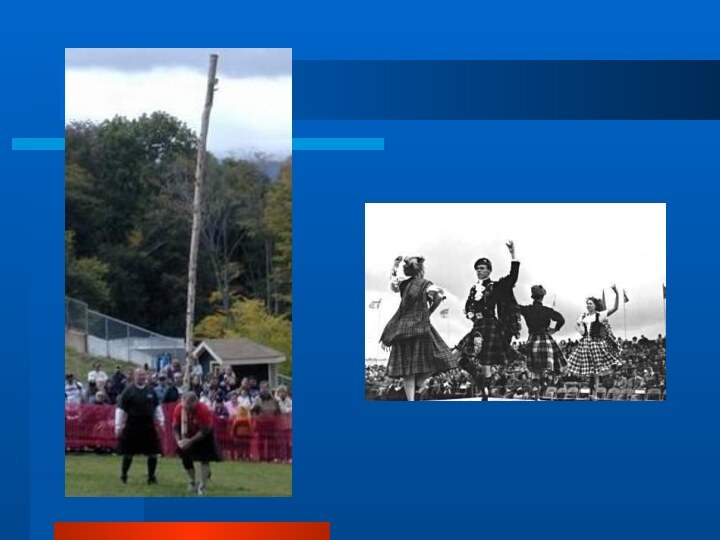



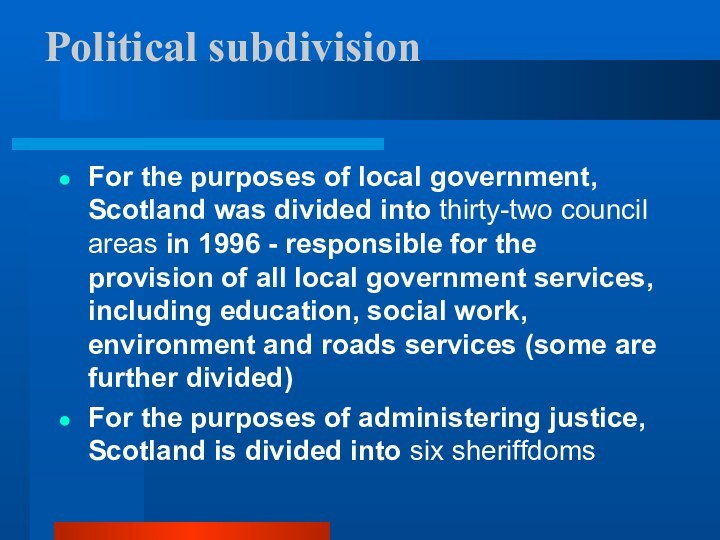
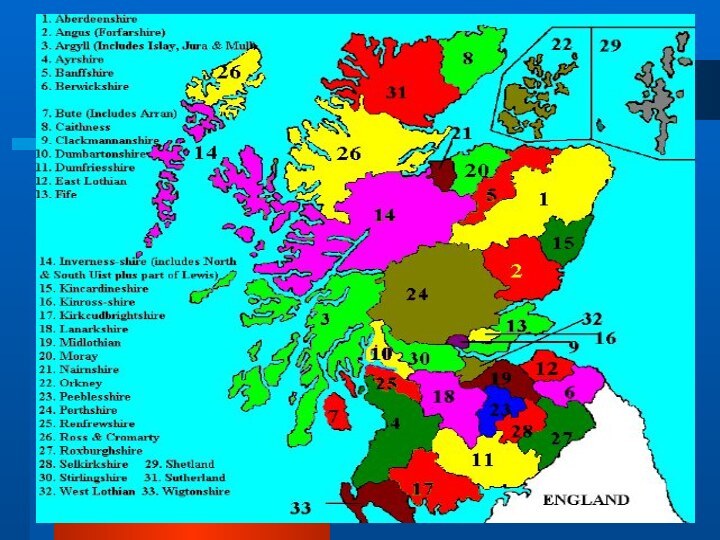






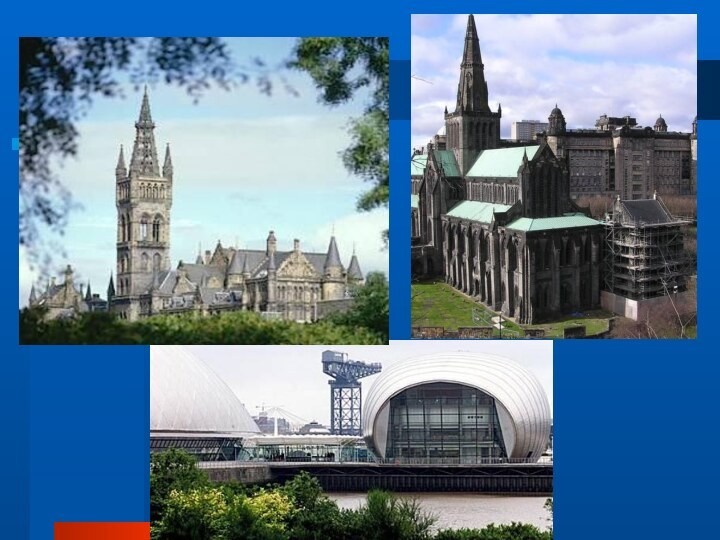




Слайд 2 Scotland, one of the four national units that make up the United Kingdom
of Great Britain and Northern Ireland.
capital of Scotland, and Glasgow is its largest city.Слайд 3 Scotland and its offshore islands comprise the northernmost part of the
United Kingdom. The Scottish mainland, which occupies roughly the
northern third of the island of Great Britain, is bordered on three sides by seas. To the north and west is the Atlantic Ocean; to the east is the North Sea. Rugged uplands separate Scotland from England to the south. The territory of Scotland includes 186 nearby islands, a majority of which are contained in three groups. These are the Hebrides, also known as the Western Isles, located off the western coast; the Orkney Islands, located off the north-eastern coast; and the Shetland Islands, located northeast of the Orkney Islands. The largest of the other islands is the Island of Arran. The total land area of Scotland, including the islands, is 78,790 sq km (30,420 sq mi).An independent nation for much of its history, Scotland was joined to England by a series of dynastic and political unions in the 17th and 18th centuries. Scotland retains a separate national identity, however, supported by separate legal and educational systems, a national church, a parliament with wide-ranging powers, and other national symbols and institutions.
Слайд 5
Rivers and Lakes
Scotland is endowed with an abundance of streams and
lakes. Most lakes are long and narrow. Notable among
the lakes, which are especially numerous in the central and northern regions, are Loch Lomond, the longest lake in Scotland; Loch Ness, which according to legend contains a sea monster; Loch Tay; and Loch Katrine.Many of the rivers of Scotland, especially those in the west, are short, torrential streams, with limited commercial importance. The longest river of Scotland is the Tay. The Clyde, which flows through the city of Glasgow and through the industrial heartland, is Scotland’s most important river and serves as a transportation outlet to the Atlantic Ocean. Other important rivers in Scotland flow east and drain into the North Sea. They include the Forth, Tweed, Dee, and Esk.
Слайд 7
Climate
Like the rest of the United Kingdom, the climate of Scotland is subject
to the moderating influences of the surrounding seas. Temperate
winters and cool summers are typical, and extreme seasonal variations are rare. Low temperatures, however, are common in mountainous parts of the interior during the winter months. In the western coastal region, where the moderating effects of the Gulf Stream are strongest, conditions are somewhat milder than in the east. The average January temperature of the eastern coastal region is 3°C (37°F), and the average January temperature of the western coastal region is 4°C (39°F); corresponding July averages are 14°C (57°F) and 15°C (59°F). The average January and July temperatures for the city of Edinburgh are 3°C (38°F) and 14°C (58°F), respectively.The most common species of trees indigenous to Scotland are oak and conifers—chiefly fir, pine, and larch. However, centuries of human settlement have resulted in widespread deforestation, and large forested areas are rare. The only significant woodlands are in the southern and eastern Highlands.
The only large indigenous land mammal in Scotland is the deer. Both the red deer and the roe deer are found. The red deer, whose habitat is the Highlands, is by far the more abundant of the two species. Other indigenous mammals are the badger, fox, rabbit and hare, otter, ermine, pine marten, and wildcat. Game birds include red grouse, blackcock, ptarmigan, pheasant, and waterfowl. Scotland is home to large numbers of seabirds, including the gannet, fulmar, and various species of gull. The few predatory birds include the kite, osprey, peregrine falcon, and golden eagle. Scotland is famous for the salmon and trout that abound in its streams and lakes. Scotland’s coastal waters are home to many species of fish, including cod, haddock, herring, and various types of shellfish, as well as to a variety of marine mammals, including the Atlantic seal, common seal, dolphin, and porpoise.
Слайд 10
POPULATION
The people of Scotland, like those of the United Kingdom in
general, are descendants of various ethnic stocks, including the
Picts, Celts, Scandinavians, Anglo-Saxons, and newer immigrant groups. Scotland is mainly an urban-industrial society with a small, sparsely scattered rural populationThe population of Scotland (2004 estimate) is 5,078,400. The population density is about 64 persons per sq km (167 per sq mi), making Scotland the most sparsely populated of the major United Kingdom administrative divisions. The highest density is in the Central Lowlands, where nearly three-quarters of all Scots live, and the lowest is in the Highlands. About two-thirds of the population resides in urban areas
Слайд 12
Principal Cities
Glasgow (population, 2001, 578,700) is Scotland’s largest city. It
forms part of the metropolis of Clydeside, which is
composed of a large number of urban areas, including Clydebank, Paisley, Kilmarnock, and Hamilton. This region is the main industrial and commercial center in Scotland. Edinburgh (449,000) is the capital of Scotland and also the country’s major administrative and financial center. The city is Scotland’s main tourist destination and hosts the Edinburgh International Festival, the largest annual arts festival in the United Kingdom. Other major cities are Aberdeen (211,300), a center for oil production and distribution, and Dundee (150,250).
Слайд 13
George Square, Glasgow
Palace of Holyroodhouse, Edinburgh
Edinburgh Castle and
Balmoral Hotel
Слайд 14
Culture
Historic cultural differences long divided Celtic Scots of the Highlands
and Anglo-Saxons of the Lowlands. Traditionally, the clan, a
grouping of an entire family with one patriarchal chief, or laird, was central to Highland culture. Clans were also important as fighting units, and they played an important role in rebellions against the British government. However, depopulation of the Highlands, which has occurred since the 18th century, fatally weakened the clan structure. Today, the clan in Scotland exists mainly as a cultural ideal rather than as a practical form of social organization. Lowland culture was more heavily influenced by the Industrial Revolution, as well as by Protestantism, which spread throughout much of Scotland during the Reformation. The extension of Highland cultural traditions to the Lowlands—including the use of clan names, kilts, and bagpipes—and the creation of a Scottish mythology and literary culture can be traced to the late 18th and early 19th centuries. At that time writers such as Robert Burns and Sir Walter Scott worked to create a unified sense of Scottish identity.
Слайд 16
Highland Dancers of ScotlandTraditional Highland dances of Scotland
began as military dances, performed before or after battle.
The Highland fling, for example, was originally performed by Highlanders to celebrate a victory, and the bagpipe is most often associated with it. Although bagpipes are found throughout the world, Scotland is probably the country most identified with the instrument. Around 1670, bagpipers began to play for the Highland troops serving the English Army. Since that time, bagpipers have accompanied Scottish troops through many wars. Here, at the annual Aboyne Highland Games, dancers perform wearing the traditional Scottish attire, including tams and kilts, while we hear Pipe Major James MacColl play a traditional tune titled “Balmoral Castle.”In the field of philosophy, Scotland has produced numerous influential thinkers, including the medieval theologian John Duns Scotus, the moral philosopher and historian David Hume, and the renowned economist Adam Smith. Among the great Scottish scientists are James Watt, who greatly improved the steam engine, Sir William Ramsay, a Nobel Prize-winning chemist, and Sir Alexander Fleming, who received a Nobel Prize for his discovery of the drug penicillin.
Слайд 18 Scotland has a rich musical heritage. The traditional instruments of Scotland include
the fiddle, clarsach (the Celtic harp), and bagpipes, an
ancient instrument that was probably brought to Scotland by Romans. Scottish music is noted for the wide use of a five-tone, or pentatonic, scale. Traditional folk tunes are not standardized, and a single song may have hundreds of variations in lyrics and music. A revival of traditional Scottish music began in the 1960s, and it continues to influence contemporary musical forms, including Scottish folk rock and Gaelic-language music.Слайд 19 Sports have an important place in Scottish life. The most popular
sports in Scotland are soccer and rugby. Professional clubs
draw a wide following, and many Scots play on amateur teams. Sports of Scottish origin, including curling and golf, also remain popular. The Royal and Ancient Golf Club of Saint Andrews, located in Saint Andrews on Scotland’s eastern coast, maintains the world’s oldest surviving golf course and is a recognized authority on the rules of golf. Shinty, a stick-and-ball game similar to hurling, is a Highland sport. The traditional Highland dress of tartans and kilts adds color to the Highland Games, a series of athletic events held annually in Scotland. A beautiful and varied natural environment supports many forms of outdoor recreation, including hiking, rock climbing, canoeing, sailing, and skiing. Indoor sports, such as billiards, darts, and bowling, also attract many enthusiasts.
Слайд 21
FOOD
Haggis – Scottish national dish, chopped lamb meat,
mixed with oatmeal, spices and whatever else, stuffed inside
the stomach of sheep and boiled for several hours, eaten together with mashed potatoes
Слайд 22
Scotch Whisky
Whisky - Scotland's national drink, in the
Gaelic it means water of life, one of the
country's biggest earners
Слайд 23
Saint Andrew
The Royal Flag of Scotland
National emblem -
Thistle
The Gaelic language -part of a family of Celtic
languages, language which is spoken in Scotland for the longest time. Gaelic speakers, mostly live in the Western Isles, the Central belt and the northern Highlands.
Слайд 24
Political subdivision
For the purposes of local government, Scotland
was divided into thirty-two council areas in 1996 -
responsible for the provision of all local government services, including education, social work, environment and roads services (some are further divided)For the purposes of administering justice, Scotland is divided into six sheriffdoms
Слайд 26 Scotland is governed as an integral part of the United Kingdom.
It is represented by 59 members in the House
of Commons, the lower house of the British Parliament. In 1999 the British Parliament devolved many of its responsibilities in Scotland to a new Scottish Parliament.The executive is formed by the party or parties that hold a majority of seats in the Scottish Parliament. A first minister, nominated by the parliament, leads the executive and also appoints the other Scottish ministers.
The Scottish Parliament
Слайд 28
Subdivisions
Historical, geographical and political areas
City status in the
United Kingdom
- granted by the British monarch (more
exactly Royal Charter)- the status does not apply automatically on the basis of any particular criteria
Currently there are six cities in Scotland: Aberdeen, Dundee, Edinburgh, Glasgow, Inverness, Stirling
Слайд 29
Edinburgh
Situated on the east coast of Scotland's central
lowlands
The capital of Scotland
- home to the Scottish
ParliamentWas one of the major centres of the enlightenment, led by the University of Edinburgh
The University of Edinburgh
- founded by Royal Charter in 1583
- the fourth oldest university in Scotland
Слайд 31
Glasgow
Scotland's largest city
on the River Clyde in the
country's west central lowlands
formerly a royal burgh
established itself as
a major transatlantic trading portGlasgow's economy - financial and business services, communications, biosciences, optoelectronics, software design, creative industries, healthcare, retail and tourism
Слайд 33
Customs of Scotland
Marriage and Family
Early families living in
the Scottish Highlands were loyal to their clan, a
unit that bound together relatives sharing a common ancestor or some other bond of loyalty. However, clans have less importance in the lives of individual family members today. Each clan is still headed by a chieftain, but the position is mainly symbolic. Contemporary members of a clan may make efforts to preserve its traditions and history. Each clan is represented by a tartan, a distinctive plaid pattern.In rural areas, the extended family can still be important, but in urban areas families tend to be small. Although relatives visit each other often, families are independent from each other. The elderly prefer to stay in their own homes and remain independent as long as possible, rather than live with their married children. Just over half of all homes are owner occupied, the lowest level in the United Kingdom.
Слайд 34
Eating
The traditional breakfast includes porridge (oats mixed with
boiled milk or water and served with sugar or,
more properly, salt). Many people now prefer other cereals to porridge and have forsaken a cooked meal in the morning. A wide variety of meat and fish is available, and the Scots eat many foods found elsewhere in Europe and other parts of the world. The Indian restaurants in Glasgow are particularly well respected. Traditionally, the Scots have favoured wholesome meals such as stews, eaten with vegetables such as neeps (turnips) and tatties (potatoes). The national dish is haggis, which is made from ground sheep entrails, mixed with oats and spices, and tied in a sheep’s stomach and cooked. Younger Scots typically eat less of this traditional fare. The national drink is whiskey (spelled 'whisky' in Scotland), the production of which contributes significantly to the economy.The Scots generally eat three meals a day. Most younger people eat their main meal in the evening, while older Scots may have it in the middle of the day. The evening meal, particularly if it is eaten quite early, is sometimes called tea.
Слайд 35
Socializing
A handshake is usual when people are introduced,
and standard English greetings such as “Hello” and “How
do you do?” are common. More informal greetings among friends include “All right?” and, in the north, “Fit like?,” to which the response is Nae sae bad (“Not so bad”), or “All right.”Holidays and Celebrations
Scotland’s national holidays are slightly different from those in England and Wales. They include New Year’s Day (1 January), Good Friday (the Friday preceding Easter), May Day (the first Monday in May), Spring Bank Holiday (the last Monday in May), August Bank Holiday (the first Monday in August), and Christmas Day (25 December). New Year’s Eve (Hogmanay) is when some of the year’s most lively celebrations take place.




